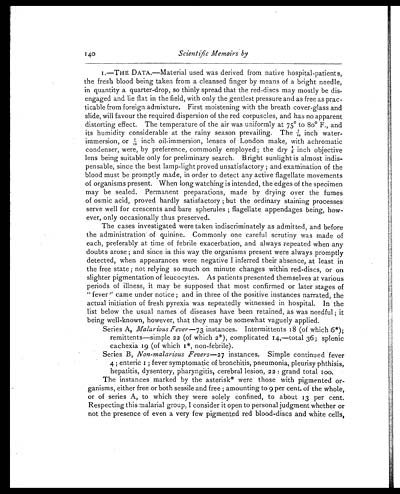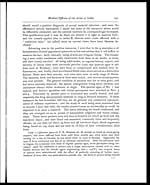Medicine - Institutions > Army health reports and medical documents > Scientific memoirs by medical officers of the Army of India > Part III, 1887 > 10 - Note on some aspects and relations of the blood-organisms in ague
(146) Page 140
Download files
Individual page:
Thumbnail gallery: Grid view | List view

140
Scientific Memoirs by
I.—THE DATA.—Material used was derived from native hospital-patients,
the fresh blood being taken from a cleansed finger by means of a bright needle,
in quantity a quarter-drop, so thinly spread that the red-discs may mostly be dis-
engaged and lie flat in the field, with only the gentlest pressure and as free as prac-
ticable from foreign admixture. First moistening with the breath cover-glass and
slide, will favour the required dispersion of the red corpuscles, and has no apparent
distorting effect. The temperature of the air was uniformly at 75˚ to 80˚ F., and
its humidity considerable at the rainy season prevailing. The 1/10 inch water-
immersion, or 1/12inch oil-immersion, lenses of London make, with achromatic
condenser, were, by preference, commonly employed; the dry 1/8 inch objective
lens being suitable only for preliminary search. Bright sunlight is almost indis-
pensable, since the best lamp-light proved unsatisfactory; and examination of the
blood must be promptly made, in order to detect any active flagellate movements
of organisms present. When long watching is intended, the edges of the specimen
may be sealed. Permanent preparations, made by drying over the fumes
of osmic acid, proved hardly satisfactory; but the ordinary staining processes
serve well for crescents and bare spherules; flagellate appendages being, how-
ever, only occasionally thus preserved.
The cases investigated were taken indiscriminately as admitted, and before
the administration of quinine. Commonly one careful scrutiny was made of
each, preferably at time of febrile exacerbation, and always repeated when any
doubts arose; and since in this way the organisms present were always promptly
detected, when appearances were negative I inferred their absence, at least in
the free state; not relying so much on minute changes within red-discs, or on
slighter pigmentation of leucocytes. As patients presented themselves at various
periods of illness, it may be supposed that most confirmed or later stages of
" fever" came under notice; and in three of the positive instances narrated, the
actual initiation of fresh pyrexia was repeatedly witnessed in hospital. In the
list below the usual names of diseases have been retained, as was needful; it
being well-known, however, that they may be somewhat vaguely applied.
Series A, Malarious Fever— 73 instances. Intermittents 18 (of which 6٭);
remittents—simple 22 (of which 2٭;), complicated 14,—total 36; splenic
cachexia 19 (of which 1٭;, non-febrile).
Series B, Non-malarious Fevers— 27 instances. Simple continued fever
4; enteric 1; fever symptomatic of bronchitis, pneumonia, pleurisy phthisis,
hepatitis, dysentery, pharyngitis, cerebral lesion, 22: grand total 100.
The instances marked by the asterisk٭; were those with pigmented or-
ganisms, either free or both sessile and free; amounting to 9 per cent. of the whole,
or of series A, to which they were solely confined, to about 13 per cent.
Respecting this malarial group, I consider it open to personal judgment whether or
not the presence of even a very few pigmented red blood-discs and white cells,
Set display mode to: Large image | Zoom image | Transcription
Images and transcriptions on this page, including medium image downloads, may be used under the Creative Commons Attribution 4.0 International Licence unless otherwise stated. ![]()
| Permanent URL | https://digital.nls.uk/75004444 |
|---|
| Shelfmark | IP/QB.10 |
|---|---|
| Additional NLS resources: | |



![[Page 139]](https://deriv.nls.uk/dcn4/7500/75004443.4.jpg)
